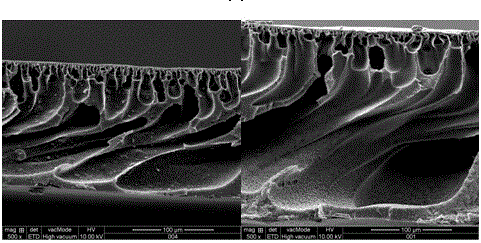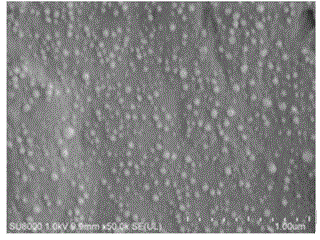Polymer film with improved antifouling property and preparation method thereof
A polymer membrane, antifouling technology, applied in chemical instruments and methods, membrane technology, semi-permeable membrane separation, etc. The effect of improving hydrophilic and hydrophobic properties
- Summary
- Abstract
- Description
- Claims
- Application Information
AI Technical Summary
Problems solved by technology
Method used
Image
Examples
Embodiment 1
[0069] Preparation of PVDF Flat Membrane with Antifouling Function
[0070] 1. Preparation of modified nanoparticles
[0071]Disperse 1 g of hydrophilic silica nanoparticles into 100 g of water with a pH value of 6, add 0.05 g of epoxy silane coupling agent KH560, and react at 95 °C for 8 hours; then add 0.08 g of lysine Amino acid, continue to react at 95 ℃ for 2 hours. After the reaction, centrifuge to collect the modified nanoparticles for use.
[0072] see figure 1 In the infrared spectrum shown, the silica nanoparticles are surface-modified with lysine, and the IR spectrum is at 1518 cm -1 and 1410 cm -1 New peaks appeared at , which were attributed to the N-H vibration of amino groups and the symmetrical stretching vibration of carboxylic acid groups, indicating that lysine had been successfully grafted on the surface of silica nanoparticles, and the surface zwitterionization of nanoparticles had been realized.
[0073] 2. Preparation of polymer films
[0074] Ul...
Embodiment 2
[0084] Preparation of PVDF hollow fiber membrane with antifouling function
[0085] 1. Preparation of modified nanoparticles
[0086] Disperse 1 g of hydrophilic silica nanoparticles into 100 g of water with a pH value of 5, add 0.2 g of KH560, and react at 95 °C for 10 hours; then add 0.3 g of lysine, and continue to React for 3 h. After the reaction, centrifuge to collect the modified nanoparticles for use.
[0087] 2. Preparation of polymer films
[0088] 0.05 g of modified silica nanoparticles and 0.5 g of PVP were ultrasonically dispersed into 60 g of NMP at a power of 100-1000 W using an ultrasonic machine, and then 10 g of PVDF was added to obtain a casting solution; the casting solution was processed after 8 hours After the vacuum defoaming treatment, put it into the spinning kettle, and extrude from the spinneret composed of two concentric tubes under the metering pump at a speed of 10 r / min and a spinning pressure of 0.5 MPa; without drying In the spinning proc...
Embodiment 3
[0096] Preparation of PES Flat Film with Antifouling Function
[0097] 1. Preparation of modified nanoparticles
[0098] Ultrasonic dispersion of 1 g of titanium dioxide nanoparticles into 100 g of water with a pH value of 6, added 0.5 g of epoxy silane coupling agent KH560, and reacted at 95 °C for 12 hours; then added 1 g of lysine, and continued at 95 °C for 6 hours. After the reaction, centrifuge to collect the modified nanoparticles for use.
[0099] 2. Preparation of polymer films
[0100] Ultrasonic disperse 1 g of modified titanium dioxide nanoparticles into 50 g of DMF, then add 10 g of PES and 0.5 g of PEG, and use a high-speed mechanical stirrer to stir and dissolve at a rate of 10000 r / min for 40 min to obtain a casting solution; After 6 hours of vacuum defoaming treatment on the casting solution, the casting solution was directly scraped into a flat film with a film thickness of 200 μm, which was immersed in a water bath at 30 °C to solidify and form.
[010...
PUM
| Property | Measurement | Unit |
|---|---|---|
| size | aaaaa | aaaaa |
| diameter | aaaaa | aaaaa |
| particle size | aaaaa | aaaaa |
Abstract
Description
Claims
Application Information
 Login to View More
Login to View More - R&D
- Intellectual Property
- Life Sciences
- Materials
- Tech Scout
- Unparalleled Data Quality
- Higher Quality Content
- 60% Fewer Hallucinations
Browse by: Latest US Patents, China's latest patents, Technical Efficacy Thesaurus, Application Domain, Technology Topic, Popular Technical Reports.
© 2025 PatSnap. All rights reserved.Legal|Privacy policy|Modern Slavery Act Transparency Statement|Sitemap|About US| Contact US: help@patsnap.com



